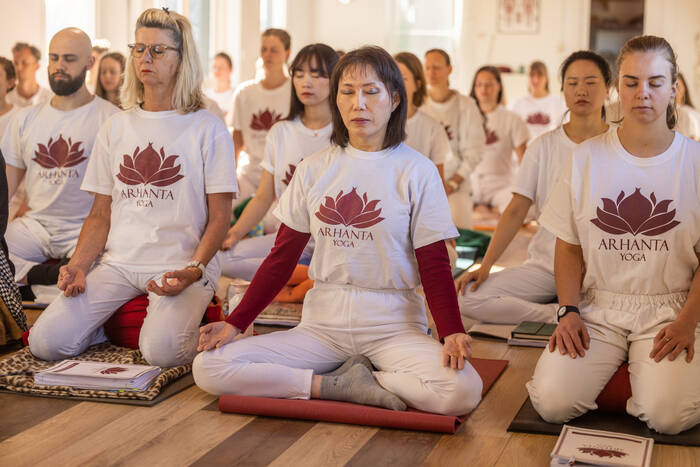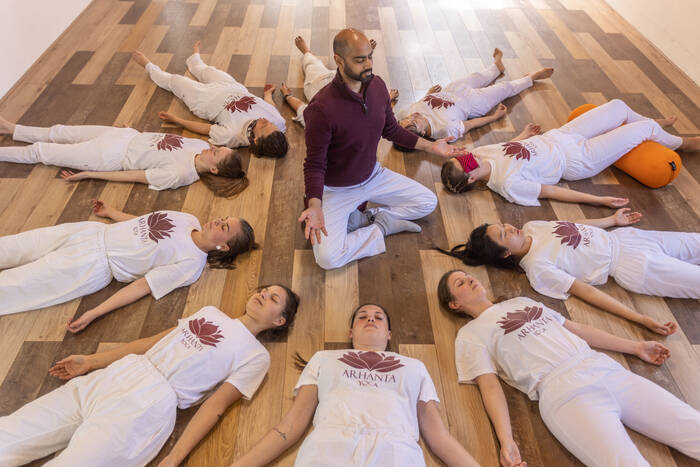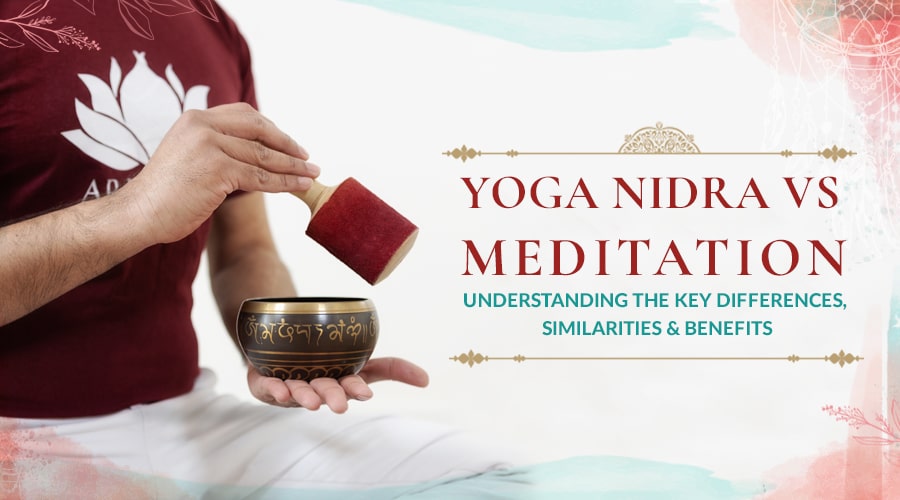When we think of the basic definitions of Yoga Nidra and meditation, it’s easy to see how these two can get mixed up. Both make use of ancient meditation techniques to crack open the conscious mind, and Yoga Nidra is even described as a guided meditation. So, are Yoga Nidra and meditation one and the same, or entirely different? Read on to discover the key similarities and differences between Yoga Nidra and meditation, as well as a few unique benefits.
What Is Meditation?

Meditation is an umbrella term used to define a practice or state of mind where an individual's level of awareness is heightened. The two most popular types of meditation found today are concentrated meditation and mindfulness meditation. These styles use focused breathing exercises to calm the mind and bring the awareness into the present moment. In this new dimension of being, we can free ourselves from the shackles of the ego and achieve spiritual awareness. According to Patanjali’s Yoga Sutras, the final stage of meditation is samadhi; where individual consciousness and universal consciousness become one. Therefore, at its essence, meditation is a path to self-realization and enlightenment.
What Is Yoga Nidra?

Also known as yogic sleep, Yoga Nidra is a style of meditation where practitioners drift into a deep state of conscious sleep. In Yoga Nidra, you are not asleep, nor are you awake. Instead, you are in an in-between place where the mind is still and calm and the body feels like a feather, much like a dreamless sleep. Yoga Nidra is a systematic practice that incorporates guided visualizations, affirmations and resting yoga postures like Shavasana (Corpse Pose) to relax the body and shift awareness from the external realm to the internal realm. Here, concepts of time, space and reason fade away. This creates the ideal environment for the Self to heal and shift into its most natural form.
Is Yoga Nidra the Same as Meditation?
Yoga Nidra and meditation share a few similar characteristics. For example, both alter states of the human consciousness through meditation techniques like concentrated breathing and affirmations. Regular practice of the two can also benefit the mind greatly, reducing stress levels, improving concentration and purging negative thought patterns.
Both practices:
- Alter the conscious mind
- Stimulate both halves of the brain
- Use passive yoga poses and promote stillness
- Practice concentrated breathing
- Make use of guided visualizations and affirmations
What Are the Key Differences Between Yoga Nidra and Meditation?
Yoga Nidra and meditation indeed have a lot in common. However, when you take a closer look at each of these practices individually, they couldn’t be more different. Whether you picked up on these nuances in your local Yoga Nidra class, or are just hearing about them now, understanding what makes each practice unique will help you choose the right style for your needs and level.
Here are some of the key differences between Yoga Nidra and meditation:
Seated Vs Lying Down
One of the most obvious differences between Yoga Nidra and meditation is posture. In traditional meditation practices, practitioners will typically sit in a comfortable seated position with legs crossed and palms facing upward or in a concentration mudra like Dhyana Mudra. This upright position grounds the practitioner into the present, helping them focus and direct their awareness inwards. Yoga Nidra on the other hand is practiced lying down in a soothing position. Yoga teachers will usually encourage students to relax in the resting pose Shavasana which encourages them to relinquish control and drift into a dreamless sleep.
Advanced Vs Beginner
In a meditation class, you’ll have to concentrate on your breath, block out the incessant chatter and step into the dark abyss of the mind. This can be quite a challenge for beginner practitioners. Yoga Nidra is a guided practice, making it easier to follow and reach the desired state of consciousness. In a Yoga Nidra class, a yoga teacher will steer you through the various stages, helping you drift into deeper brainwave states naturally. After some time, you’ll have gained the skills and knowledge to focus and control the awareness alone.
Guided Vs Solo
Also known as guided meditation, Yoga Nidra is typically practiced in a class with an experienced instructor. During a Yoga Nidra class, the teacher will guide you through various stages of relaxation. First, you’ll be asked to develop an intention for the practice. With your intention firmly in your mind, you will be prompted to focus on your breath, bodily sensations, emotions, and thoughts. The purpose of this guided mind and body scan is to gently lull you into a dream-like state without forced concentration or extreme effort. Meditation on the other hand is typically practiced solo. Yogis learn how to draw their attention inwards using various meditation techniques such as a body scan, candle gazing and focused breathing. This can be quite challenging and can often take years to master.
Active Vs Passive
Yoga meditation is an active training of the mind that demands effort, commitment and complete concentration. In traditional meditation, practitioners have to learn how to draw their attention to a single point of focus in order to reach a receptive state. Yoga Nidra is far less rigid in comparison. Using resting postures and calming props like blankets and pillows, Yoga Nidra encourages the mind to let go and naturally drift into a deep state of relaxation, just like nodding off after a long day. You are not steering your awareness in the desired direction but allowing it to be carried by the current of the universe. It’s important to remember that even though your physical body is resting, your mental body is still active and in an observing state.
Deep Relaxation Vs Spiritual Awareness
The most significant difference between meditation and Yoga Nidra is the intention of the practice. Yoga Nidra is a rejuvenating ‘sleep' which relaxes the mind and bodily senses, promoting self-awareness in the process. Meditation is not practiced for relaxation, but rather to enter a highly conscious state where spiritual growth and awareness can begin.
Relax deeply with our guided Yoga Nidra

Receive an exclusive 25-minute Yoga Nidra session with master teacher Ram Jain
Yoga Nidra Vs Meditation: Which Is Better for Your Health?
There’s no question that Yoga Nidra and meditation are extremely beneficial for the mind, body and soul. Regular practice can calm an overactive mind and even guide practitioners to inner peace and spiritual liberation. However, as each practice takes you to a different state of consciousness, some practitioners might benefit from one more than the other.
This is particularly true for individuals who suffer from anxiety and high-stress levels. A recent study analyzed the impact of Yoga Nidra and seated meditation on the anxiety and depression levels of college professors. The study found that Yoga Nidra was more effective in reducing anxiety and stress levels, positioning it as a promising therapeutic tool for reducing cognitive and physiological symptoms of anxiety.
While Yoga Nidra might be more effective in alleviating anxiety and stress, traditional meditation boasts its own unique benefits which have helped many practitioners improve their physical health and gain control over their emotions and lives. Here are a few key benefits of Yoga Nidra and meditation respectively:
Yoga Nidra Benefits
Meditation Benefits
Can You Practice Both Yoga Nidra and Meditation?
It’s a common misconception that you can’t practice both Yoga Nidra and meditation. You most certainly can. In fact, you should. With a daily dose of Yoga Nidra and meditation, you’ll not only elevate your practice but enjoy all the wonderful benefits each practice offers. A great way to integrate these two is to begin lying down in Shavasana with Yoga Nidra, and gradually move your way up to seated meditation. This offers an easier transition, helping you flow from deep relaxation into a transcendent state.
Final Thoughts
Although there are many differences between meditation and Yoga Nidra, both are effective tools for peeling back the layers of the conscious mind and deepening your practice. Whether you choose to practice Yoga Nidra, meditation, or both, delving below the surface of the mind will allow you to dig up deep-rooted samskaras and connect with your truest, most authentic Self.
Relax deeply with our guided Yoga Nidra

Receive an exclusive 25-minute Yoga Nidra session with master teacher Ram Jain

